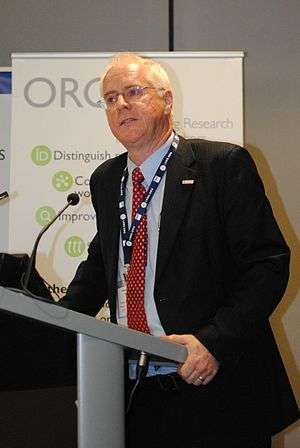Keith Nugent
Keith Alexander Nugent (born 28 June 1959) is an Australian physicist.[1] He is Deputy Vice-Chancellor and Vice-President (Research) at La Trobe University and a Professor of Physics at the University of Melbourne, Australia specialising in X-ray optics and near-field optics. He was born in Bath, England. He received a first class honours degree from the University of Adelaide[2] and his postgraduate degree from the Australian National University in Canberra.
Keith Nugent | |
|---|---|
 | |
| Born | 28 June 1959 |
| Nationality | Dual Australian-English |
| Alma mater | Australian National University, University of Adelaide |
| Known for | |
| Scientific career | |
| Fields | Physicist |
| Institutions | University of Melbourne |
In 1989 Professor Nugent in collaboration with Dr. Stephen Wilkins pioneered a form of X-ray optics known as lobster-eye optics. Using the capillary structure found in lobster eyes, Nugent and Wilkins were able to design telescopes with a 360 degree view of the sky.[3] This was initially planned to be used in a LOBSTER satellite which would, indeed, conduct 360 degree surveys of the sky,[3] though never came to fruition.[3] NASA currently have plans to use the technology to view space objects and phenomena from the International Space Station.[4]
In 2001 Nugent was made a Federation Fellow by the Australian Government. This position was renewed in 2006.[5] He also chairs the Sciences Advisory Board of IATIA, a company designed to commercialise some of his inventions. Nugent is a fellow of the Australian Academy of Science (FAA). He sits on the Advisory Board of the Australian Synchrotron.
Since 2005 Nugent has been director of the ARC Centre of Excellence for Coherent X-ray Science, based at the University of Melbourne, where he has driven the development of coherent X-ray diffraction methods for imaging biological structures.[6] His other research focusses on the complete recovery of phase from intensity and the applications of this to imaging.[7] This work is currently being used to monitor wear in car engines[4] and has potential for research into the treatment of cancer.[2]
In 2011 Nugent was appointed part-time Director of the Australian Synchrotron.
He was appointed as Deputy Vice-Chancellor and Vice-President (Research) at La Trobe University in January 2013.[8][9]
Academic achievements, awards and honors
- Two R&D 100 Awards (1988 and 2002).[10]
- The Walter Boas Medal (1997) of the Australian Institute of Physics[11]
- The Edgeworth David Medal (1993) of the Royal Society of New South Wales[1]
- The Pawsey Medal of the Australian Academy of Science, of which he was elected a Fellow in 2000
- A 2003 Centenary Medal by the Federal Government for outstanding contributions to science
- 2004 Victoria Prize for pioneering work with quantitative phase imaging.[2]
- Member of the National Science Advisory Committee of the Australian Synchrotron
- Member of the Expert Advisory Committee for Physics, Chemistry and Geosciences.
References
- "Nugent, Keith Alexander (1959-)". Trove. National Library of Australia. Retrieved 11 May 2012.
- "Professor Keith Nugent". Business Victoria. 2007-03-25. Archived from the original on 2007-03-25.
- "Archived copy". Archived from the original on 2007-09-30. Retrieved 2006-10-02.CS1 maint: archived copy as title (link)
- "Australian Synchrotron - June 2006: Lightspeed". 7 September 2006. Archived from the original on 2006-09-07.
- "ARC Centre of Excellence in Coherent X-ray Science (CXS)". www.coecxs.org.
- "ASSN: Profile:". 18 September 2006. Archived from the original on 2006-09-18.
- "Synchrotron loses director". 21 August 2012.
- University, La Trobe. "New appointment for La Trobe". www.latrobe.edu.au.
- "Archived copy". Archived from the original on 2006-09-18. Retrieved 2006-10-02.CS1 maint: archived copy as title (link)
- "Walter Boas Medal". Australian Institute of Physics. Archived from the original on 17 March 2012. Retrieved 11 May 2012.
External links
| Wikimedia Commons has media related to Keith Nugent. |